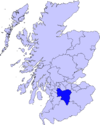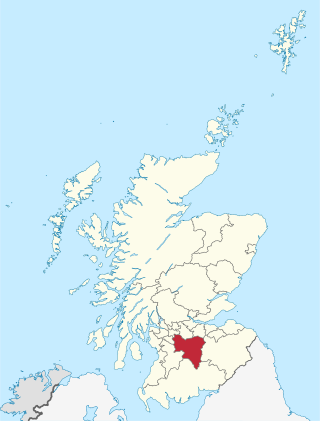
South Lanarkshire is one of 32 unitary authorities of Scotland. It borders the south-east of the Glasgow City council area and contains some of Greater Glasgow's suburban towns, as well as many rural towns and villages. It also shares borders with Dumfries and Galloway, East Ayrshire, East Renfrewshire, North Lanarkshire, the Scottish Borders and West Lothian. It includes most of the historic county of Lanarkshire.
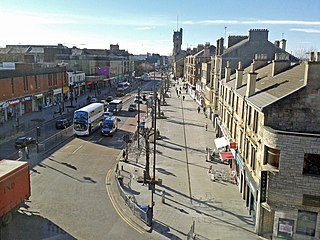
Rutherglen is a town in South Lanarkshire, Scotland, immediately south-east of the city of Glasgow, three miles from its centre and directly south of the River Clyde. Having previously existed as a separate Lanarkshire burgh, in 1975 Rutherglen lost its own local council and administratively became a component of the City of Glasgow District within the Strathclyde region. In 1996 the towns were reallocated to the South Lanarkshire council area.

East Kilbride, sometimes referred to as EK, is the largest town in South Lanarkshire in Scotland, and the country's sixth-largest locality by population. Historically a small village, it was designated Scotland's first "new town" on 6 May 1947. The area lies on a raised plateau to the south of the Cathkin Braes, about eight miles southeast of Glasgow and close to the boundary with East Renfrewshire.

Thomas McLaughlin McAvoy, Baron McAvoy, was a British Labour and Co-operative politician serving as a life peer in the House of Lords from 2010 until his death in 2024. He served as Member of Parliament (MP) for Glasgow Rutherglen from 1987 to 2005, and Rutherglen and Hamilton West from 2005 to 2010.

Carmunnock is a conservation village situated within the Glasgow City council area, lying within three miles of East Kilbride and Rutherglen in South Lanarkshire and Busby in East Renfrewshire. The nearest other district within Glasgow is Castlemilk.
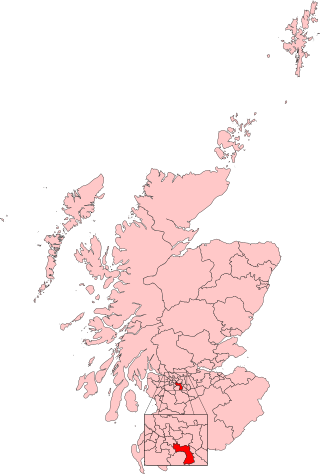
Rutherglen and Hamilton West was a burgh constituency of the House of Commons of the Parliament of the United Kingdom, which was created for the 2005 general election. It covered almost all of the former constituency of Glasgow Rutherglen and most of the former constituency of Hamilton South, and it elected one member of parliament (MP) by the first-past-the-post voting system.

Rutherglen is a burgh constituency represented in the House of Commons of the Parliament of the United Kingdom since 2024. It also existed between 1918 and 2005 and was largely replaced by Rutherglen and Hamilton West while a small portion became part of Glasgow Central and Glasgow South.

Eastfield is a mainly residential district in South Lanarkshire, Scotland, located between the industrial towns of Rutherglen and Cambuslang in the south-east of the Greater Glasgow urban area. It is situated south of the River Clyde, adjoining the Stonelaw and Burnside neighbourhoods of Rutherglen, and Silverbank in Cambuslang.

Fernhill is a residential neighbourhood in the Scottish town of Rutherglen in South Lanarkshire; it is situated south of the River Clyde and borders the Rutherglen neighbourhoods of High Burnside to the north and Cathkin to the east, the Glasgow district of Castlemilk to the west, and the open lands of Fernbrae Meadows to the south. Its location on a steep incline which is part of the Cathkin Braes range of hills offers panoramic views over the south and eastern parts of Greater Glasgow.

Burnside is a mostly residential area in the town of Rutherglen in South Lanarkshire, Scotland. Including the neighbourhoods of High Burnside and High Crosshill, respectively south and north-west of its main street, it borders Overtoun Park in Rutherglen plus several other residential areas of the town, as well as western parts of neighbouring Cambuslang.

Kirkhill is a district of the town of Cambuslang, South Lanarkshire, Scotland.

Trinity High School is a Roman Catholic secondary school located in Eastfield, Rutherglen, Scotland near the city of Glasgow. It was established in 1971. The current head teacher since 2024 is Carol McArdle, following on from Allison Craig who had taken office in 2021 following the retirement of Peter Bollen.
The History of Cambuslang is explained to a great deal by its geography. Now in South Lanarkshire, the town of Cambuslang is an ancient part of Scotland where Iron Age remains loom over 21st century housing developments. It has been very prosperous over time, depending first upon its agricultural land, then the mineral resources under its soil.

Gilbertfield Castle is a ruined 17th-century castle in South Lanarkshire, Scotland. It is located at NS652587, on the north slope of Dechmont Hill, just outside Cambuslang, to the south-east of Glasgow.

Halfway is a largely suburban area in the town of Cambuslang, Scotland, located within the local authority area of South Lanarkshire. It borders the smaller areas of Lightburn, Cairns, Flemington, Drumsagard and Hallside.

Drumsagard Village is a new construction village in Cambuslang, South Lanarkshire. It is built around the site of Drumsagard Castle and immediately south of the site of Hallside Steelworks.
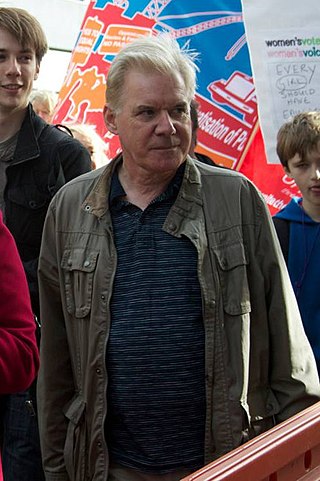
Bill Bonnar is a founding member of the Scottish Socialist Party.

Whitlawburn is a residential area in the town of Cambuslang in South Lanarkshire, Scotland. It is located south of the town centre on high ground slightly north of the Cathkin Braes, overlooking the Greater Glasgow urban area.

Cambuslang West is one of the 20 electoral wards of South Lanarkshire Council. Created in 2007, the ward elects three councillors using the single transferable vote electoral system and covers an area with a population of 14,096 people.

The A724 road in Scotland runs within South Lanarkshire between Rutherglen and Hamilton. It follows an ancient route which is marked on William Roy's Lowland Map of Scotland (1755) with only minor deviations from its modern course.

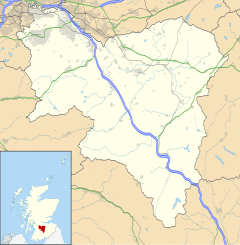










![Cambuslang Miners Monument "In memory of the men, women and children, many of whom died whilst working in the pits and collieries of Cambuslang [...] Also to the memory of Mick McGahe Cambuslang Memorial.jpg](http://upload.wikimedia.org/wikipedia/commons/thumb/d/df/Cambuslang_Memorial.jpg/220px-Cambuslang_Memorial.jpg)



















